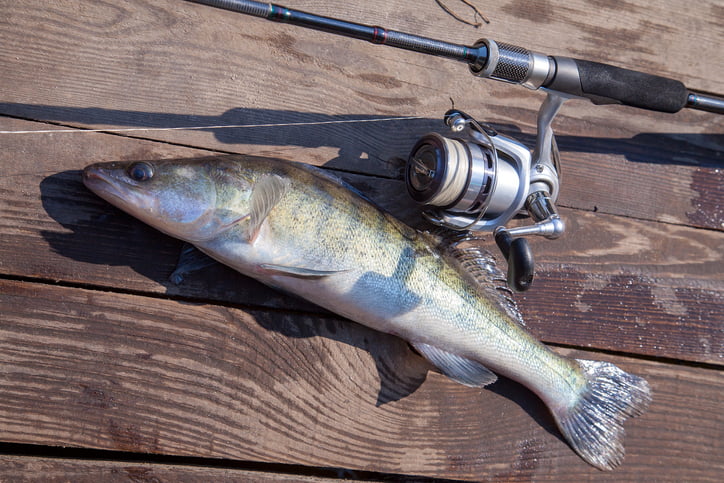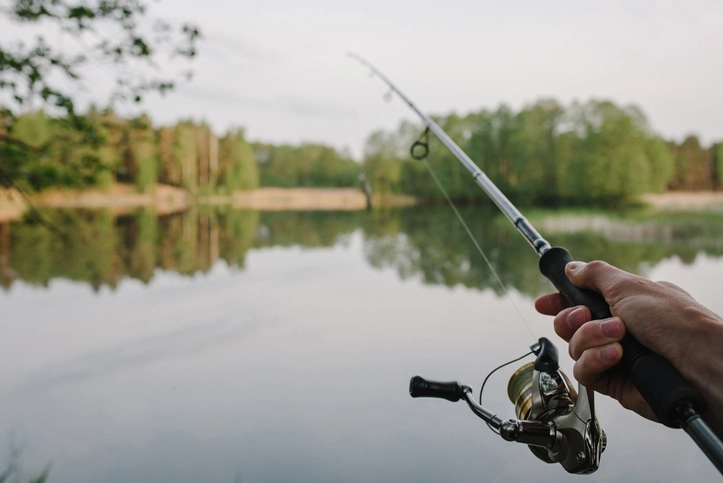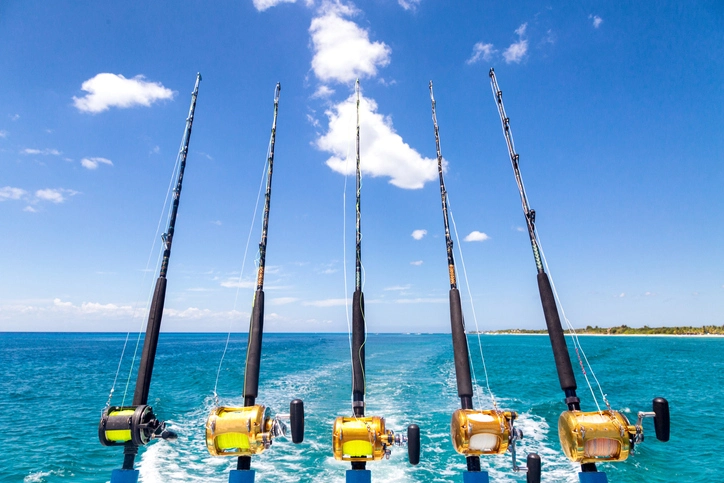Whether you’re a novice angler or an experienced one looking to perfect your baitcasting skills, you’ve come to the right place. This comprehensive guide will delve into the intricacies of baitcasting and highlight the crucial role fishing rods play in achieving success on the water.
But first of all let us discuss what baitcasting is.

What is Baitcasting?
Baitcasting is a skillful and precise technique that involves casting an artificial or natural lure using a reel with a revolving spool, which is attached to a silk or nylon line.
Unlike fly casting, baitcasting utilizes a shorter and less flexible fishing rods. This technique requires careful coordination and control to achieve accurate and effective casts.
Mastering The Baitcasting Technique
Baitcasting seems daunting at first to anglers new to this type of technique. While using traditional casting techniques, the line unwinds off of a stationary spool. With baitcasting, the spool spins to unwind the fishing line.
This is an efficient system for using heavier braided lines and getting longer casting distances because you don’t have as much drag on the stationary spool that you have with spinning reels.
However you have to deal with the dreaded overrun, also known as a bird’s nest or backlash. In fact, if you plan on fishing for bass with heavier lines and lures, learning how to cast a baitcasting reel will give you an advantage.
Choosing the Right Baitcasting Reel
A baitcaster, also known as a casting reel, is ideal for anglers targeting large fish in heavy cover. It allows for precise casts in dense vegetation or under overhanging tree limbs. With the ability to manage thick braided and fluorocarbon lines, a baitcaster is essential for these situations. Not limited to weeds, a baitcasting combo excels in open water as well, providing access to areas that a spinning rod and reel cannot reach.
Types of Baitcast Reels
- Round Profile
Round baitcaster reels are prized by anglers for their capacity, power, and drag, making them ideal for targeting different species. Although they are heavy and bulky, they are excellent for handling sizable fish. Round profile casting reels excel in controlling larger fish, earning them popularity among freshwater and saltwater anglers.
The larger circumference of round-profile reels allows for larger drag washers, providing increased surface area. As a result, they can withstand greater pressure, making them suitable for larger and more aggressive game fish species.
Round reels are commonly used for targeting catfish and salmon in large rivers and saltwater fishing. They hold ample lines for long casts from the bank and help reach the bottom. They also balance well on heavier rods needed for fighting large fish.
- Low Profile
Low-profile baitcasters are a popular choice for anglers, especially when fishing jigs or soft plastic worms. These reels are lightweight, allowing for easy balance on bass fishing rods. They also come in sub-categories, such as Bait Finesse Systems (BFS), which are smaller and optimized for lightweight presentations. This makes low-profile baitcasters a great option for finesse anglers accustomed to spinning reels.
Certain low-profile reels feature a handy flipping switch. The switch allows anglers to quickly engage the reel when their lure hits the bottom. This improves the chances of a successful hookset. Flipping is a technique used in dense cover, requiring fast water coverage and attentiveness to detect bites.
There are low-profile baitcasters offering a line capacity between a round reel and a low-profile casting reel. These particular reels are favored by saltwater anglers and bass anglers who use larger swimbaits.
Selecting the Ideal Rod for Baitcasting
To master baitcasting, a high-quality rod is crucial for success. It’s indispensable for targeting large fish and maneuvering through dense vegetation. With many options to choose from, finding the perfect rod can be daunting, especially for beginners.
To help you choose the right one, we have created a guide for you to check.
Features to Look for in Baitcasting Fishing Rods
- Rod Blank
The fishing rods’ blank supports its components. It gives anglers sensitivity, action, and backbone for feeling bites, presenting lures, and setting the hook. Blanks are made of different materials like:
- Graphite – The go-to material for rod blanks is graphite, which combines carbon fibers with epoxies. Graphite is light, rigid, and offers excellent sensitivity for feeling bites and detecting underwater structures. Anglers benefit from using a top-notch graphite blank by catching more fish and reducing fatigue during long periods of fishing.
- Fiberglass – Fiberglass rod blanks are cheaper and more durable than graphite, but they are also heavier and less sensitive. The slower action of a fiberglass rod is useful for presentations like catfishing or using treble-hooked lures.
- Composite – Composite rod blanks are a smart choice for anglers seeking lightweight, durable rods with a slower action. By combining the benefits of carbon fiber and fiberglass strands, these rods offer versatility and excel in various fishing techniques.
- Rod Length
The length of fishing rods is crucial for performance. Finding the right length for master baitcasting is crucial. Going too long affects accuracy, while going too short limits casting distance and leverage.
For small pond and lake fishing, a 5-6ft rod allows accurate casts and detects faint bites. A versatile option for bass and similar species is the 6-7ft fishing rods, offering accuracy, lure control, and easy transport.
For longer casts and control, an 8-12 ft baitcasting rod is ideal. When angling for catfish, a longer fishing rods provides leverage against resilient fish in deeper spots. Float fishing for salmon and steelhead benefits from longer fishing rods, enabling extended casts and effective line management. This keeps the lure drifting naturally with the current and maximizes chances of catching fish in prime spots.
- Grip
The grip section of a casting rod, also known as the handle, runs from the reel seat to the butt of the fishing rods. Different types of grips are available, each with its advantages.
- Split Grip
A full-grip baitcasting rod securely holds the entire blank beneath the reel, allowing for a seamless and secure hold. The longer butt section benefits anglers making long casts with heavy lures. The extended grip provides a larger surface area for better control and leverage when battling with large fish.
- Full Grip
A full grip rod covers the entire blank beneath the reel for a secure hold. It has a longer butt section, great for long casts with heavy lures. The extended grip provides a larger surface area for better control and leverage, especially with weighty lures and big fish. This improves casting distance and handling in challenging fishing situations.
- Cork
A cork handle on a baitcasting rod offers anglers multiple advantages. Its lightweight nature enhances sensitivity, making it ideal for certain techniques. Cork is hydrophobic, repelling water and preventing waterlogging, ensuring comfort. Additionally, cork is eco-friendly, being both recyclable and biodegradable, minimizing environmental impact.
However, cork grips require regular cleaning and sealing and have some durability limitations. Nevertheless, if comfort and sensitivity are top priorities, a cork grip is an excellent choice for a baitcasting rod.
Advanced Techniques for Baitcasting
- Thumb Control: Feather the spool with your thumb to control the line during the cast.
- Backlash Prevention: Adjust the reel’s braking system to prevent backlashes.
- Precision Casting: Improve accuracy by targeting specific objectives.
- Pitching: Perfect for targeting fish hiding under cover, master baitcasting is the go-to technique.
- Feathering the Spool: To prevent a sudden stop and minimize splash, feathering entails releasing the spool tension just before the lure touches the water.
- Wind Casting: Improve casting accuracy on windy days by adjusting your technique and aiming into the wind.
- Thumb Pressure Variation: Vary thumb pressure throughout the cast: more during acceleration, less as lure approaches target.
- Accuracy with Jigs: To master baitcasting, precision is key. By practicing accurate casts, anglers can imitate the movement of prey.
- Underhand Cast: Mastering the underhand cast is essential for discreetly approaching calm waters.
- Casting Angles: Experiment with different casting angles to find the most effective presentation for the conditions.
- Swim Jig Retrieval: Vary swim jig speed to catch different fish.
- Lure Pop and Pause: Add a pop and pause to your lure retrieval to imitate wounded prey.
- Walking the Dog: Walking the dog is a popular topwater technique that uses a rhythmic rod tip movement to create a zigzag motion.
- Roll Casting: The roll cast is a precise, compact cast ideal for confined areas.
- Spoon Jigging: Mastering the art of spoon jigging is crucial for effectively presenting your bait in deep water.
- Double Fluke Rigging: Using two flukes on a single line boosts the size and appeal for bigger predators.
Increase Distance with Baitcast
- Don’t fill the spool – Baitcasters allow for frictionless casting to the bottom of the spool, even with less line. This increases efficiency, distance, and prevents line rubbing on the frame.
- Match rod action to lure weight – To achieve more distance when casting lighter lures, opt for a medium-power rod instead of a medium-heavy power rod. This allows the rod to load more on the backcast, increasing the casting distance for 1/4 or 3/8 ounce lures.
- Correct your casting motion – Keep your elbows bent and tight instead of extending your arm completely straight. This will make the rod load and unload with more power.
- Set less brakes with braid – Braid is lighter and tighter on a spool than monofilament or fluorocarbon. This allows for less brakes on your reel, resulting in greater distance and better efficiency.
- Line up your line guide – Ensure the line guide is centered on the reel for smoother casting and less friction.
- Use braid as backing – Braid is a great choice for casting distance if you use backing. Wrapping the line tightly around the spool increases its diameter without adding weight, allowing for faster and more efficient spinning.
- Let out more line – A longer leash enables anglers to cast heavier lures with greater distance. This advantage technique allows for deeper casts and prolonged time in the strike zone, resulting in higher catch rates for bass fishing with deep crankbaits.
- Thumb hard first – Increase baitcaster distance by training your thumb to act as the brakes. Loosen tension and brakes for a freer spinning spool. Begin with tight tension and press the thumb bar to prevent the lure from dropping off the rod tip. Gradually decrease tension until the bait barely falls, then train your thumb.
FAQS:
- What type of rod should I use with a baitcaster?
Baitcasting rods are specifically designed to complement baitcast and spincast reels.
- How do you aim with a baitcaster?
Aim for your target by preparing your cast by bringing the rod back over your shoulder. Depress the thumb bar while keeping pressure on the line spool. Remember that depressing the thumb bar will release the line.
- How do I get more distance with my baitcaster?
To increase your distance with baitcasters, train your thumb to act as the brakes. This allows you to reduce tension and brakes, resulting in a freer spinning spool. Begin with tight tension and push the thumb bar.
- Why are baitcasters hard to use?
One drawback of baitcasting is the possibility of backlash. This occurs when the spool spins faster than the lure, causing the line to become knotted.
- Why do pro fishermen use baitcasters?
Baitcasters excel at flipping and pitching with heavier lures, allowing for a stronger hook set and quick retrieval of fish in dense vegetation. They also support the use of heavier fishing lines.
Conclusion:
Mastering the art of baitcasting is a fulfilling pursuit for anglers, and the key to success lies in selecting the appropriate fishing rods. Through our exploration of the intricacies of baitcasting, it has become clear that choosing the right fishing rods is important for a seamless experience.
Understanding rod action, power, and length contributes to casting with accuracy and control. Therefore, investing your time in selecting a perfect rod and practicing will soon have effortless mastering on baitcasting technique.
Additional Resources:
- Guide on how to cast: https://www.curated.com/journal/352000/how-to-cast-a-baitcaster-the-basics-and-beyond#:~:text=You%20begin%20by%20holding%20the,line%20tight%20onto%20the%20spool.
- How to cast a baitcaster: https://www.wired2fish.com/fishing-tips/how-to-cast-a-bait-caster
- Right and wrong way on holding a baitcasting reel : https://www.lafishblog.com/how-i-hold-a-baitcaster/
- Setting up baitcasting reels: https://www.bass-fishing-source.com/baitcast-reels-setup.html
- 3 Basic cast with baitcasting rod and reel: https://www.mercurymarine.com/us/en/lifestyle/dockline/how-to-make-the-3-basic-casts-with-a-baitcasting-rod-and-reel


